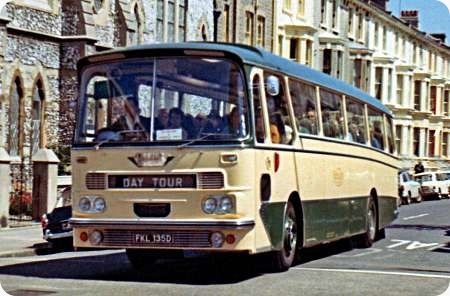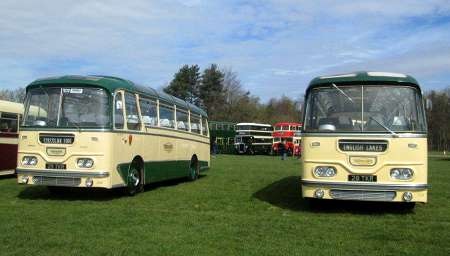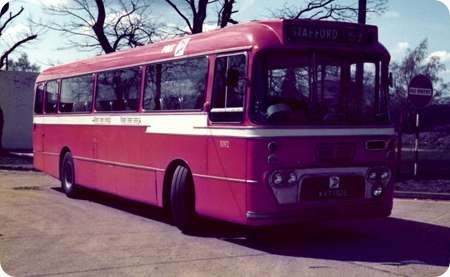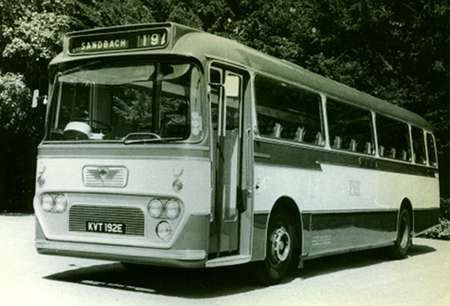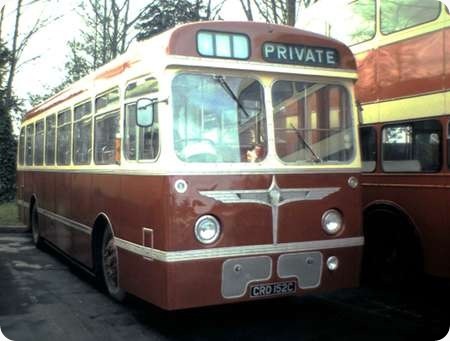Maidstone & District – AEC Reliance – FKL 135D – C72
Maidstone & District Motor Services Ltd
1965
AEC Reliance 2U3RA
Harrington Grenadier C47F
Comparing the various body styles available in the sixties amongst my photos I decided that my all time favourite had to be the Harrington Grenadier.
This Maidstone & District example with it’s superb livery which complemented the sleek elegant lines of the bodywork was as near perfection as was possible, this particular vehicle was numerically M&D’s last Grenadier and also their last AEC Reliance and was still numbered C72 under the old alpha/numeric system when I took the photo in the late sixties.
They were good to look at, good to ride on and an absolute delight to drive what more could you ask.
Photograph and Copy contributed by Diesel Dave
07/06/13 – 05:54
Following on from the Sheffield Regent III/Weymann, another form of bliss and perfection. Apart from the beauty and elegance of the coachwork and the thoroughbred 2U3RA chassis we have M & D. Apart from the superb livery itself, why did M & D vehicles always gleam – and other operators could make their vehicles look shabby at an early age. Care and pride certainly – but that cannot be all.
David Oldfield
07/06/13 – 07:59
Used to regularly see these vehicles up close at Victoria Coach Station and DD and DO are totally correct in what they say – these and other M&D vehicles stood out amongst the multitude of operators and liveries.
The rear wheel trims used widely in the fleet and the proportions and shades of the colours used always seemed to fit their vehicles well and, yes, they were always clean.
Under NBC standards slipped and by the time I went to live in Crowborough in the mid 1980s the fleet was nothing to write home about, especially during the invasion of the Mercedes bread vans.
The final M&D colour scheme prior to the privatised company losing its identity was a return to the standards of the 1960s but that soon went under the bland uniformity of Arriva.
Phil Blinkhorn
07/06/13 – 11:34
As a number of you know already, my ‘formative years’ were spent in the Lancaster area. Ribble had Harringtons – Cavaliers – of both 30 and 36 foot lengths. I’m not sure why, but I always had the idea that the 36 group looked too long. Looking at this beauty, I think I know why. The Ribble ones had the red stripe under the windows. Here, the relevant area is cream, and it looks a lot better! Thanks for posting, Dave.
Pete Davies
08/06/13 – 08:03
Taking up David’s point about gleaming vehicles. Before pride became a dirty word, NGT group vehicles were all hand painted, and finished off with a coat of clear varnish. I cant speak for other depots, but coaches at Percy Main were never subjected to the rigors of the mechanical wash, so they were always immaculately turned out, perhaps M&D did the same
Ronnie Hoye
08/06/13 – 08:04
I can’t help but agree with the previous comments regarding the Harrington Cavalier and Grenadier coach bodies. They were indeed graceful-looking beasts and must surely rank as one of the great British design classics. They suited the elegant spa town of Harrogate very well, when either gracing the front of The Old Swan Hotel on Swan Road (Southdown Leyland), or on occasions the Hotel St George on Ripon Road (Greenslades AEC). If luck was in, smart Northern General (AEC) and East Yorkshire (Leyland) examples could also be seen travelling through the town. The Maidstone & District livery suited them admirably, and the backdrop in your photo Diesel Dave, looks ‘just right’ as well, and thank you for posting it.
Brendan Smith
08/06/13 – 08:04
36-foot Cavaliers looked over-long because they had too many small windows, which is precisely why the Grenadier was introduced. Plaxton similarly built multi-windowed 36-foot Embassies for only one season (mainly for Wallace Arnold) before doubling the window size.
I may have said this here before, but it is worth noting that the Harrington Grenadier was the final flourish of the British curvy-coach tradition that began in the mid-1930s. After that, everything was straight-waisted.
Peter Williamson
08/06/13 – 17:51
Hopefully before anyone else spots my mistake I must point out that C72 was probably not M&D’s last Reliance although definitely their last Reliance coach, it was delivered in November ’66 as was a batch of Marshall D/P bodied Reliances No’s SC 73-82 all of which had higher chassis numbers.
Diesel Dave
03/05/14 – 08:51
Looking splendid in their original green and cream livery these two 30′ M & D Harrington Cavaliers were on display at Detling Showground April 2014. They are the two survivors from the batch delivered in 1962, 25 & 28 TKR on an AEC Reliance chassis.
Peter Jewell
06/02/15 – 06:24
I worked for the Maidstone & District motor services during the early 1960`s from Tunbridge Wells depot, primarily as an OMB where we had to operate the entrance doors. Occasionally we got hold of a "main key" shift which entailed driving a double decker on the longer routes to Brighton, Hastings, Ashford or Gravesend. All of the vehicles concerned IE Leyland PD2s, AEC Regents were fitted with rear doors operated from the drivers cab and the rear platform with the driver primarily responsible. The only complaints from the conductor were if the driver forgot to close the doors when pulling away from a stop.
Reg Stubbs
13/02/15 – 06:15
I was for a few years a conductor and then a driver working For M & D at Gravesend depot from 1969. I am amazed that three vehicles associated with this depot from my time have survived into preservation, including 4025 or C25 in its original guise. This was a superb vehicle to drive and many a happy time was had going to Brighton or Ramsgate in this vehicle. The coach that tended to be allocated to me at Gravesend was a Grenadier and one of the six longer (37.5ft) coaches; and the only one allocated to Gravesend. I can agree they were superb looking vehicles and a treat to drive
Frank Weston
Quick links to the - Comments Page - Contact Page - Home Page
